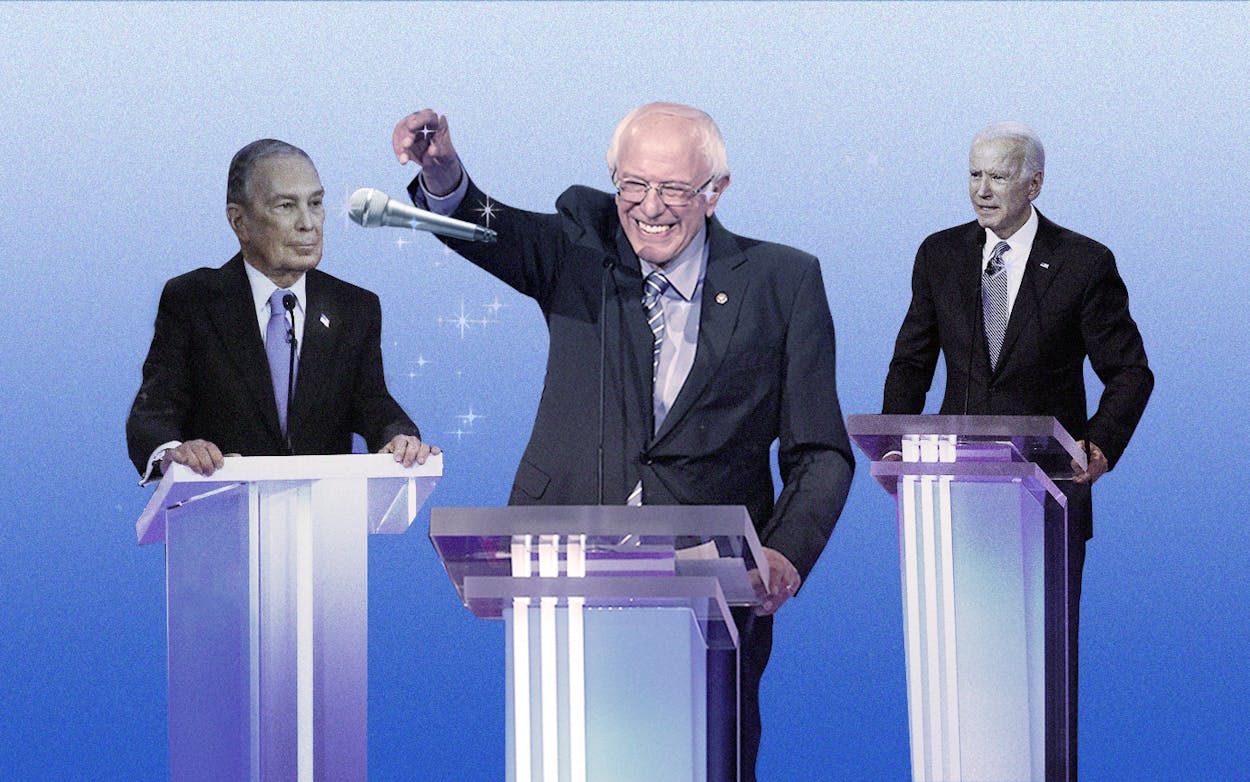The fourteen-month reality show that has been the 2020 Democratic presidential primary reaches its midseason finale on Tuesday, when Texas—along with California and a dozen other states—finally starts counting ballots for the party’s nomination.
For most of the year-plus that voters have been contending with the question of who they will nominate to challenge Donald Trump, Texans have leaned toward either Beto O’Rourke or Joe Biden. After O’Rourke dropped out in November, the former vice president enjoyed an average lead of about ten points over rivals Bernie Sanders and Elizabeth Warren. But things started to shift in late January, when Warren’s stock began to fall and Biden and Sanders started running within a few points of each other in Texas.
The newfound competitiveness of the Texas primary and Sanders’s rise as the party’s polling leader nationally have coincided with the start of something else, too: namely, the candidacy of former New York City mayor Mike Bloomberg.
Bloomberg has made an aggressive push for Texas (even if it’s unclear how long he intends to maintain the organization he’s building here), with an overt appeal to the same moderate voters that Biden’s campaign has long been targeting. And while there’s been a correlation between the relative polling of the two candidates, we haven’t had a direct way to see the extent to which Bloomberg’s candidacy was siphoning voters away from Biden—and toward a Sanders victory in Texas. That is, until Wednesday, when Public Policy Polling and Progress Texas (PPP) released a new poll.
That poll asked likely Democratic primary voters who they support in two different scenarios—one with Bloomberg as an option, and one without. When Bloomberg is an option, he comes in third place, with 17 percent of the vote, behind a Biden/Sanders tie at 24 percent. When Bloomberg’s name isn’t listed, though, Biden shoots up to 31 percent, while Bernie stays relatively the same at 25 percent support. (Others who lose a chunk of support when Bloomberg is listed include Elizabeth Warren, who goes from 17 percent to 14 percent, and Amy Klobuchar, who goes from 7 percent to just 4 percent.) Sanders’s path to winning Texas, in other words, is a lot easier if he’s able to go through both Biden and Bloomberg.
And the Biden campaign has noticed. Digital director Rob Flaherty, in response to the poll, tweeted that the Bloomberg campaign is, in effect, an independent expenditure benefiting the candidacy of the democratic socialist from Vermont.
The Bloomberg campaign is the best-funded pro-Bernie IE in history https://t.co/ZxFy7NBaDa
— Rob Flaherty (@Rob_Flaherty) February 26, 2020
That’s probably not an outcome that Bloomberg, whose campaign has started selling hats that read “Not a Socialist,” actually wants. Bloomberg’s Texas director Ashlea Turner told me last week—and the campaign reiterated on a conference call with reporters on Tuesday—that they expect to win Texas, not just put up a respectable showing. And it’s probably true that were Biden the one to drop out, Bloomberg might see enough of a benefit to make his campaign competitive with Sanders’s. (Although, given that Biden is the leader in polling and, unlike Bloomberg, has actually accumulated delegates so far, that is a harder case to make.) But as long as the two are both clearly running in the moderate lane of the primary, Texas is a lot likelier to award more of its delegates to Bernie Sanders than to anyone else.
Of course, Bernie might get there on his own. The tie with Biden in the poll follows a handful of polls in mid-February that show Bernie with a lead and Bloomberg pulling less than the 17 percent of support that he saw in the PPP poll. Still, with just a handful of days to go before we stop talking about Texas in the theoretical terms of polling and start talking in the actual numbers of pledged delegates, the state of the race suggests that Biden and Bloomberg’s beef benefits Bernie.
- More About:
- Politics & Policy
- Joe Biden
- Bernie Sanders








